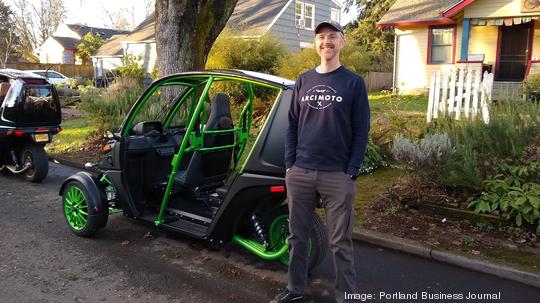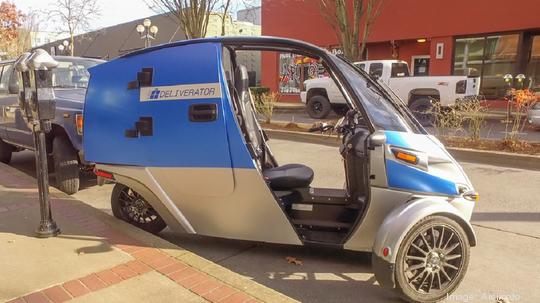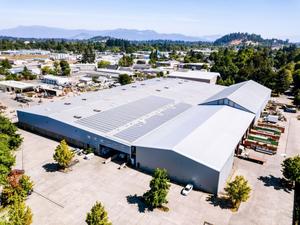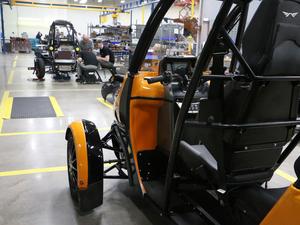“I Pitti the fool who goes short on a sustainable future,” Mark Frohnmayer tweeted on a recent Sunday night.
The Arcimoto Inc. chief executive wasn’t tripped up by spell-check — he was referring to Alex Pitti, who had posted two articles critical of Arcimoto on SeekingAlpha.com, including one that questioned the company’s market capitalization when it topped $1 billion early this month.
Pitti insisted he’s not shorting the stock (Nasdaq: FUV), but the tweet was deft work by Frohnmayer, and not just for the pun.
In fewer than a dozen words he positioned Arcimoto as a target of short sellers, encouraging those who like the company to stick with it if the stock declines, while raising the possibility of a new squeeze play. And he wrapped the suggestive jab in a reminder that the three-wheeled electric vehicle maker is all about saving the world.
Frohnmayer has just 3,000-plus Twitter followers, but the episode typified the indefatigable and disarmingly bold way the former gaming-company founder with the familiar Oregon family name has guided his quirky little EV venture in recent years — and given it, shockingly, a chance to succeed.
Deliverators, Rapid Responders, the Roadster, DHL vehicle delivery, Mark Wahlberg’s FUV, an Orlando deployment, new markets, a new factory, an acquisition — Arcimoto’s PR firm pumped out the press releases and Frohnmayer made these the topics of discussion at a time when the whole world seemed to be looking for an EV company to invest in.

“There's so much news happening with Arcimoto and with EVs,” said Michael Shlisky, who covers Arcimoto as a senior equity research analyst at Colliers Securities. “How do you even find a moment to sit down and think about what the valuation is? When you think you’ve got it, within a day, it’s already old news.”
Revenue for Arcimoto, now in its 14th year, is microscopic — a little more than $600,000 in the first quarter of 2020, the last (mostly) pre-pandemic quarter. The burn rate has long been well above $1 million a month. But after raising more than $50 million on the back of a stock that rocketed up 721% in 2020, the company has money in the bank that should carry it well into 2022.
That level of capitalization is new to Arcimoto, which was founded in 2007 with a chunk of Frohnmayer’s GarageGames exit haul “in the mid-seven figures.”
The company teetered on the brink regularly as Frohnmayer toiled through seven vehicle design iterations before arriving at the current FUV. Then it pulled off an $18-million-plus IPO in 2017. That was enough to set up a Eugene factory and begin eking out production — there are now around 150 FUVs in the wild — an accomplishment that sets Arcimoto apart from many better-funded companies in the bubbly EV sector.
But making that vehicle, in the manner and scale that Arcimoto was doing it, wasn’t sustainable. The first retail model was priced at $19,900, far from the $11,900 target Frohnmayer had long talked about. Even the $17,900 base price that would come later was far too high.
The big strategy turn now underway is to tweak the FUV and the manufacturing process to allow for scaling to 50,000 vehicles per year “within two years,” a goal Frohnmayer announced in August. Then, the theory goes, the price can move toward that old target, broadening the market.
“Probably 75% of the months of Arcimoto’s lifetime we’ve had less than three months’ runway in the bank,” Frohnmayer said. “In that situation, you can make plans all you want, but to be able to really execute efficiently, you've got to have more runway.”
‘What up, HyperChange?’
To gain it, Frohnmayer has courted investment pros — like Shlisky — but he regularly carves out chunks of time for the rising retail crowd that thrives on YouTube. Just this month, Wall Street Journal readers who made their way deep into a piece about teen stock traders would have encountered Mya Parker, age 13. She’s learned about investing from watching YouTube channels, the Journal reported, and “now she posts videos detailing her thoughts on her investments in companies like electric vehicle maker Arcimoto.”
Frohnmayer hasn’t appeared with Parker, not yet at least, but he did do an interview with Zachary Cox, who began the YouTube channel Young Investor last September at age 12. Cox bought Arcimoto stock in October, when it traded around 6 bucks, telling his viewers then that he thought it had “10x potential.”
Within a couple of months, the stock was more than halfway there. And Cox, who has around 7,000 subscribers, was a guest on HyperChange, which has 145,000 subscribers. It’s a Frohnmayer favorite and has had an enormous impact on Arcimoto.
The show is hosted by a smart, fast-talking, ballcap-wearing 28-year-old Tesla devotee named Galileo Russell, Gali to most, who begins each episode with the greeting, “What up, HyperChange?” and favors the word “epic.” He had busted into the news cycle in May 2018 when Elon Musk, accepting Russell’s offer to be the voice of the retail investor in a Tesla earnings call, unceremoniously dumped professional analysts and talked with Russell for more than 20 minutes.
In early January, after several appearances on HyperChange, Frohnmayer brought Russell onto the Arcimoto board, thrilling Russell’s fans. A short-biased hedge fund that didn’t want to be named had a different view.
Frohnmayer, an analyst from the fund said, was using the YouTuber to shamelessly “play to retail investors” in a way that avoided scrutiny and rigor — fitting with an alleged tendency by the CEO to highlight exciting announcements of distant developments while burying missed production targets and product recalls. Plus, Russell as a board member delivering EV investment insights on YouTube created “a blatant conflict of interest.”
That didn’t make sense, Frohnmayer said.
“It’s quite the opposite,” he said. “Galileo is now very restricted in what he can say about Arcimoto on his channel. Previously, he was just incredibly bullish in his channel on Arcimoto, and schemed about our future plans and what could we be doing and all this. He can't do any of that now.”
Russell, Frohnmayer continued, is on the Arcimoto board because “he has provided very thoughtful, strategic advice for the company that is actionable.”
Frohnmayer credits Russell, for instance, with introducing him to Sandy Munro, a Detroit lean-production guru who has his own Tesla connection that has made him an unlikely YouTube star at age 72.
Munro is known for his Tesla “tear-downs,” where he literally disassembles vehicles to learn how they’re made, what’s good, what’s not. Musk, taking time from handing the Richest Man in the World crown back and forth with Jeff Bezos, recently spent an hour chewing the fat on Munro Live.
Munro & Associates is consulting for Arcimoto on its scale-up, a fact that has become a key part of Arcimoto’s story of a company heading in the right direction. Munro himself hasn’t been shy about promoting Arcimoto’s prospects, with Arcimoto’s aid. In an Arcimoto-produced video, Frohnmayer asked Munro to describe his level of confidence that Arcimoto could scale up to 50,000 units per year.
“I’m totally confident,” Munro said, seemingly taken aback by the suggestion it could be otherwise. “Arcimoto’s future is brilliant,” he went on to say.
‘Making cars is hard’
Other observers aren’t so sure. Edward Niedermeyer studied another ex-software guy’s tortured effort to scale EV production in his book “Ludicrous: The Unvarnished Story of Tesla Motors.”
“The single phrase I’ve said more than any other in the past 10 years in a professional setting, it's that making cars is hard,” he said. He calls it “the 90-10 problem,” where getting 90% toward a product is relatively easy, but that last 10%, is devastatingly difficult.
“Tesla is able to pull together prototypes really fast,” Niedermeyer said. “They're able to get them to market quite fast. The designs are good, the engineering is good, the performance is good. But where they fall short is on the execution stuff, specifically the manufacturing.”
That’s been Arcimoto’s experience. Production has been slow, but mechanical issues and recalls have come quick. That FUV that Mark Wahlberg rhapsodized about for Arcimoto, that got big play on TMZ.com, was in the service center earlier this month, as the company fixed an electrical system issue in all its delivered vehicles.
As much as Niedermeyer thinks the FUV is a cool product, he sees another challenge for Arcimoto too. Teslas appeared to be futuristic when they came on the scene, but they weren’t functionally all that different than traditional cars. The FUV is a radical departure.
“When you have something that is both futuristic and novel, like the FUV, you have a massive psychological hurdle,” Niedermeyer said. “People are going to have to try it before they buy it and they’re going to have to go out of their way to find it. That makes me very pessimistic about their consumer projects.”
He thinks Arcimoto’s Deliverator could have a better chance. It’s the FUV with the back seat removed, replaced with around 20 cubic feet of cargo space for restaurant and grocery delivery by the likes of Door Dash and Freddy's, or any kind of package on its last mile.

This is a view shared by Ross Gerber, an investor who Frohnmayer included among the good things that Galileo Russell has brought to Arcimoto.
Gerber pops up frequently on business chat shows and fought the Tesla short-seller wars on the long, winning side, emerging rich and looking for more EV action. Turned on to Arcimoto by Russell, he’s begun buying stock in the company, which he believes could be worth $3 billion if it can scale along the lines Frohnmayer has outlined.
“It’s far from a sure thing, and I would caution investors in every small company,” Gerber said in an interview. But he sees the world moving fast toward Frohnmayer’s vision of “right-sized transportation,” especially with the Deliverator.
“They're trying to get the price point down to $12,000,” Gerber said. “So if you think about a payment on a $12,000 vehicle over a five or six year period, for $125 a month you could be delivering food and actually improving your margins by hundreds of dollars a month.”
Gerber was on HyperChange recently, along with Frohnmayer. A few days later, the hedge-fund short seller emailed that Gerber hadn't revealed until near the end of the hour-and-10-minute video that he was an investor in Arcimoto. True, but the morning after the video posted Gerber had tweeted to his 124,000 followers that he was invested in Arcimoto.
It's not his style to be shy about his positions.
“When we take an investment in a company, we don't just sit back and hope that they're successful,” Gerber said. “We take an active role, and I took a very active role in helping Tesla succeed, one of many who did. I think we can do the same thing with Arcimoto, take this company, help it market its product, help management manage the business correctly, be there for them when and if they need capital, which I'm sure they will, and help them become a solution for climate change.”
‘Insanity of the short sellers’
Arcimoto is a speck next to the sun that is Tesla in the EV universe, but the short seller attacks on Arcimoto are setting up a dynamic familiar to Tesla watchers and investors.
The most recent Nasdaq data showed about a fifth of Arcimoto’s shares sold short — nothing near the stratospheric GameStop peak of 140%, but still a big number. Told that short sellers were deriding the addition of Russell to Arcimoto board, Gerber erupted.
“You tell them that I stuck the last group of shorts with $38 billion in losses,” he said. “If they think that this is just some pump-and-dump scheme, they’re going to lose a lot of money and I’m going to make sure of it. OK? This is about sustainable transportation.”
Russell said the shorts once more don’t get it, and their efforts to instill FUD — fear, uncertainty and doubt — in investors will fail. And that goes for their attacks on his hiring to the board.
“That just epitomizes the insanity of the short sellers, that Arcimoto’s most brilliant moves — maybe I’m super biased — is what they look at as a weak point. This is going to be so cutting edge. I’ve literally given to Arcimoto probably hundreds of thousands, if not millions of free advertising dollars, because I’m an influencer with almost a million people a month tuning into my content.”
Another thing Gerber and Russell agree on: Frohnmayer is a big asset.
“The CEO, Mark, is very determined. He’s put all his money into this, his whole life into this. I love that. That’s what you want out of a CEO,” Gerber said.
Frohnmayer goes about his obsessiveness in a low-key, studied way. He tends not to reveal much personally, but over time the Eugene in him begins to show through: Vibram FiveFingers running, meditation, Tibetan prayer flags on the house, yoga.
And, of course, a mobility solution that isn’t just fun, but chips away at the hegemony of several-ton behemoths powered by climate-warming internal-combustion engines.
In a January video chat with electrical engineering and computer science students at Berkeley, his alma mater, Frohnmayer said he was an introverted kid who found refuge in the computer.
In a subsequent interview, he added detail to that answer, alluding to Fanconi anemia, a rare disease that took the lives of his three sisters.
“When I think about growing up, I think about climbing trees and playing kick the can,” Frohnmayer said. “Things got a lot darker when that disease came into our family. Then the computer became a refuge.”
His late father, Dave Frohnmayer, was in the public eye as a state legislator, Oregon attorney general, gubernatorial candidate and longtime University of Oregon president.
“Every rough personal detail became a newspaper article in the (Eugene) Register-Guard,” Frohnmayer said. “I think that’s why I shied away from media for a long time.”
That guardedness has worn off, certainly when it comes to evangelizing for Arcimoto. Talking about the company, Frohnmayer said, is “a huge part of the job.”
‘We don't promote the stock’
He dismissed short-seller accusations that he’s tipped into misleadingly promoting the stock.
“We don't promote the stock, but we certainly let people know that there is a stock, right?” Frohnmayer said. “A lot of our video content is just about telling people what the company is doing. We're not saying ‘Go buy this stock.’ We’re saying, ‘Here is our mission, here are our products, here's how we build them. Here's our plan going forward.’ And people make up their own minds about what they want to do.”
Still, Frohnmayer has shown a growing willingness to take on critics, as he did with Pitti — on Twitter, and in the comments section on SeekingAlpha.com.
The Pitti piece was titled “Arcimoto Is Not a $1 Billion Company.” A week after its Feb. 4 publication, that was true: Arcimoto’s stock had slid from a closing high of $36.65 to $28.20, putting its market cap around $960 million. The stock continued to fall in the days ahead, dipping below $20, though Pitti wasn’t taking credit.
“Just lucky timing” he texted in reply to whether The Pitti Effect was responsible.
It bears noting that Arcimoto last March was trading at $0.97, was down to $1.9 million in cash on hand, and faced a pandemic. With money in the bank now, even at $15 it would be many times more valuable than it was not long ago.
And there’s this: In January, Arcimoto reached a broker agreement to sell up to $80 million of new stock into the market at the going price when it sees fit to do so. These “at the market” or ATM sales need only be noted in quarterly filings. If Arcimoto has taken bites of the apple — building its cash position, but diluting the stock — Frohnmayer wasn’t saying.
“What I’ve told the market is we ended the year in the strongest financial position we’ve ever been in, with the resources we need to tackle our next challenge,” Frohnmayer said.
While Arcimoto “reserved the right to be opportunistic” with regard to leveraging its stock for capital, he added, it had another plan for its next stage of financing: the U.S. Department of Energy’s Advanced Technology Vehicle Manufacturing Program. The loan program, which aided Tesla in 2010, has been moribund for years, but Arcimoto has been talking seriously since last April about making a run at what would be low-cost, non-dilutive financing.
“We now have an administration that is making very big claims about where the country is going to go,” Frohnmayer said, “and we believe we're now in a position to show we can fit very well into those plans.”






